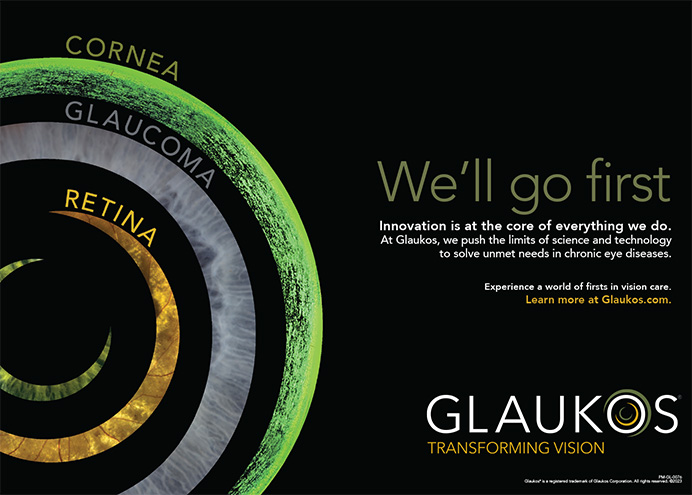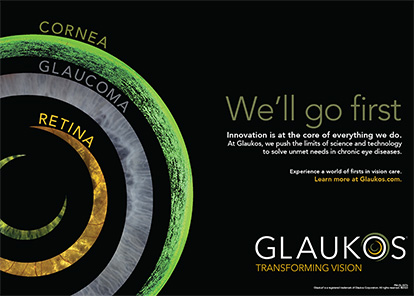CASE PRESENTATION
You perform flawless cataract surgery on a patient and implant the latest presbyopia-correcting IOL technology. The IOL is perfectly centered. The manifest refraction is +0.75 +0.50 x 090º postoperatively, yet the patient is less than thrilled.
QUESTIONS FOR THE PANEL
1. What is your response when the unhappy patient asks, “What happened?”
2. What is your process to determine why the patient is dissatisfied?
3. Refractive error is ruled out as the cause of the patient’s dissatisfaction. When do you give up on the lens and consider an IOL exchange? If you proceed with a lens exchange, which IOL would you choose—a monofocal IOL or a different presbyopia-correcting IOL?
4. Would you charge the patient for the extra work?
5. An IOL exchange can be tricky, especially if the initial surgery took place many years ago. Some studies have suggested that meticulous capsular bag cleanup and capsule polishing reduce the risk of complications with an IOL exchange. Have you modified your cataract surgery technique to anticipate the potential need for an IOL exchange?

Lucio Buratto, MD
The clinical scenario presented in the case is unfortunately familiar. A similar situation of mine from 2018 comes to mind. A 68-year-old man with amblyopia in his left eye presented with cortical and nuclear cataracts in each eye. He was hyperopic with a manifest refraction of +2.75 D OD and +3.75 -1.25 x 2º OS. He desired freedom from spectacles for distance and intermediate vision.
Uncomplicated bilateral cataract surgery was performed. Both eyes received an extended depth of focus IOL (AT LARA, Carl Zeiss Meditec), with a toric model chosen for the left eye.
Two days after surgery, the patient’s UCVA was 20/25 OD and 20/70 OS. The patient stated that his reading vision was poor and that he was experiencing dysphotopsias and fatigue with both his distance and near vision.
I met with the patient several times to demonstrate my support and determine how best to address his concerns. The Schirmer test score was 0 mm OU, and other lacrimal tests indicated moderate dry eye disease. The patient underwent intense pulsed light treatment and received a prescription for artificial tears. He also received glasses to address the distance and near vision in his right eye only (+1.25 -0.75 x 80º with a 2.50 D addition).
None of these efforts was successful. Four months after surgery, the patient underwent an IOL exchange for a monofocal IOL in both eyes. A toric model was implanted in the left eye, and a mini-monovision strategy was used (-1.00 D refractive target in the nondominant eye). The patient was satisfied with the outcome because he could see at distance and intermediate without glasses and required them only for near vision.
IDENTIFYING THE CAUSE OF DISSATISFACTION
When patients are unhappy with their surgical outcome, I explain that it may take a few weeks to evaluate the situation and determine the source of their complaints. I begin by asking them to explain the reasons for their dissatisfaction. Are they experiencing pain or a poor quality of vision? To what extent are their symptoms affecting the activities of daily living?
In addition to aberrometry and topography, diagnostic testing is performed to evaluate the quality of vision, quality of the tear film, and health of the lacrimal glands.
IOL EXCHANGE
I generally ask patients to wait at least a few months before considering an IOL exchange. Neural adaptation occurs during this period, and various strategies are employed to address their specific complaint(s). I avoid performing an Nd:YAG laser capsulotomy during this time because an open posterior capsule renders IOL exchange more complex.
If the patient in the case presented is still unhappy 3 or more months after cataract surgery, an IOL exchange would be performed—likely for a monofocal IOL—at no additional charge to the patient.
I have not altered my standard technique for cataract surgery based on the possible need for an IOL exchange. I always polish the posterior capsule as well as I can.

David Lockington, MB BCh, BAO(Hons), FRCOphth, PhD
The source of the patient’s complaint and concern is unclear. The question, “What happened?” puts the surgeon on the defensive from the start. In this sort of situation, I find it is best to respond, “Can you explain what you mean?” This prompts the patient to expand on (and vent about) their experience. Whether or not their concern is clinically significant, it matters to the patient. The best strategy is therefore to listen, respond, and provide a clear explanation rather than to dismiss their concern.
NONCLINICAL VERSUS CLINICAL ISSUES
Nonclinical. If the issue here is not clinical, I would thank the patient for their feedback, address the specific concern if required, reassure them if appropriate, and let them know I will take their comments into consideration.
Clinical. If the issue is clinical, I would explain to the patient that I wish to optimize their visual system by reevaluating the ocular surface, anterior segment, IOL, capsule, vitreous, and macula through clinical assessment and imaging as appropriate. Simply demonstrating negative or normal findings can reassure a patient. A dysfunctional ocular surface is a frequent cause of patients’ postoperative dissatisfaction. Another potential cause is a newly experienced phenomenon such as vitreous floaters or a temporal crescent shadow caused by negative dysphotopsia. Learning that these phenomena should become less troublesome over time can be a great relief to patients.
If the issue is intrinsic to the IOL and a residual refractive error has been ruled out, I would revisit the preoperative discussion about IOL choice, including the intended visual outcome and expected quality of vision. I would be reluctant to perform an early IOL exchange, especially if the issue was covered during informed consent and before choosing the IOL. In this situation, I would recommend a 6-month period of neural adaption to maximize the patient’s binocular vision. If the patient requests further surgery, I would emphasize the rare but real risk of visually significant surgical complications when obtaining informed consent.
If an IOL exchange is ultimately required, a 27-gauge needle filled with a dispersive OVD would be positioned bevel up to ensure visibility of the tip during mechanical separation of the anterior capsular opening from the IOL. Once separated, OVD on a Rycroft cannula would then be used to help viscodissect the optic. Once the optic is free, my attention would shift to the haptics. Countertraction with intraocular forceps holding the capsule may be required to encourage separation. If one or both of the haptics are attached to the capsule by fibrosis, they would be amputated and left behind. Once free, the IOL would be prolapsed into the anterior chamber, and a new IOL would be inserted beneath the original. With the capsule protected by the new IOL, the original IOL would be cut to 75% of its diameter with intraocular scissors. The original IOL would then be rotated for extraction through the main incision and positioned to resemble a fish’s mouth so that enlargement of the wound is not required. An intracameral injection of antibiotics and a subconjunctival injection of a steroid would be performed to conclude the case.

J. Morgan Micheletti, MD
I would begin by reassuring the patient that we are on the same team and share the goal of finding the right outcome for their lifestyle and personal preference. The key is to align oneself with the patient instead of becoming defensive or brushing off their concerns.
Patient COUNSELING and DISCUSSION
Preoperative counseling. Thorough preoperative counseling can help prevent surprises on the patient’s part by setting realistic expectations. This is especially important for patients who have a history of refractive surgery and those interested in advanced technology IOLs.
With the former group, I discuss the complexity of the IOL calculations and the impact of higher-order aberrations in lens selection. When patients are considering an advanced technology IOL, I explain that these lenses are their best chance of reducing their need for glasses rather than a guarantee of complete spectacle independence—although many times spectacle independence is achieved.
Postoperative discussion. The starting point is clarification of the patient’s exact visual complaint. If the problem is blurred vision, then I would focus first on the refraction. If the refraction doesn’t explain the patient’s visual acuity, then a thorough ocular surface exam and topography are the next steps, followed by OCT imaging of the macula to rule out edema depending on how much time has elapsed since surgery. If the patient’s dissatisfaction is caused by visual dysphotopsias, then residual refractive error and problems with the ocular surface should be ruled out as contributing causes. The amount of time that has elapsed since surgery is important as well because more time may be needed to achieve the final lens position and the stabilization of corneal incisions, including limbal relaxing incisions and astigmatic keratotomies. In rare instances, a patient may be unable to achieve neural adaptation or tolerate certain advanced technology IOLs.
INTERVENTION
If residual refractive error, IOL centration, and other abnormalities are ruled out as problems and the patient is dissatisfied, an IOL exchange would be performed. If the implant is a multifocal IOL, my inclination would be to offer an extended depth of focus IOL before reverting to a monofocal IOL.
Some individuals in the patient’s situation experience neural adaptation and a reduction in symptoms over time. The decision on how long to wait before intervening is a balance between the patient’s symptoms and the amount of time that has passed since surgery. I have successfully performed IOL exchanges on patients as late as 10 years after the original procedure, but I prefer to return to the OR within a few months of surgery. If an IOL exchange is performed on a patient with a toric or advanced technology IOL, it would be at no additional cost to the patient because visual satisfaction is included in the packages that my practice offers.
I have not modified my cataract surgery technique to account for a possible future IOL exchange given they happen so infrequently. Anecdotally, I have not noticed that small differences in my technique have appreciably improved the ease of an IOL exchange performed in the first 6 months, which is when I am most likely to return to the OR. Differences in haptic design make certain IOLs easier to explant, but I have not altered my IOL choice based on these characteristics.

F. Beau Swann, MD, MS
It’s no wonder that the patient is unhappy with a spherical equivalent of 1.00 D. They paid out of pocket for an excellent refractive result and ended up with hyperopia. People who upgrade to premium cataract surgery tend to be highly demanding and expect to achieve their version of perfection.
BOMB DETECTION
I charge my staff with identifying actual and potential problems in our clinic. They are on the lookout for poor-tasting coffee in the waiting area and for patients who may be impossible to please or who are unhappy with the results of presbyopia-correcting surgery. This helps us to defuse a bomb before it goes off. I know why a patient is unhappy before I walk into the room.
I would first attempt to disarm the patient by saying, “I am not happy with your vision,” or “This is not what we were aiming for,” as soon as I walk in the door. The idea is to let them know that I am on their team and am not happy with the outcome, either. Next, I would explain that, despite rigorous preoperative testing and ocular surface optimization, surgery sometimes misses the mark. I would note that we have sophisticated equipment, formulas, and techniques but that the human body is unpredictable and can heal differently than expected despite our best efforts.
In my experience, the most effective way to defuse situations like this one is to let the patient know that I am as unsatisfied with the results as they are. This attitude must be conveyed sincerely. Most patients nod along but are not satisfied until I offer a solution.
MANAGEMENT
If the patient’s complaint is related to the technology (eg, glare and halos), I would counsel them to wait at least 3 to 6 months to allow neural adaptation to occur before considering intervention. In my experience, with careful patient selection and the setting of proper expectations preoperatively, an IOL exchange is rarely required after a postoperative period of adjustment.
I guarantee my work. When patients sign up for a premium IOL, they are choosing a package that includes ocular surface optimization, laser cataract surgery, intraoperative wavefront aberrometry, a premium IOL, and a promise of satisfaction. They make a single payment, and the cost of any additional treatment is borne by the practice. A LASIK or PRK touch-up is offered when the refractive target is missed. If an IOL exchange is necessary after a postoperative period for neural adaptation, the original IOL would be replaced with a monofocal IOL.
I firmly believe that ophthalmologists who describe themselves as refractive cataract surgeons must have a skillset beyond what they learned in residency. This includes but is not limited to the ability to perform an IOL exchange, secondary IOL implantation, and excimer laser ablation safely and align a toric IOL using intraoperative wavefront aberrometry.

Caroline Watson, MD
When dealing with an unhappy patient, particularly one with an unsatisfactory hyperopic refractive result, my first step is to ensure that they feel they are heard and show that my team and I care about their experience and surgical result. Refractive misses can happen despite a thorough cataract surgery workup that includes ocular surface optimization for several weeks before surgery, topography measurements with two different machines, specular microscopy, OCT of the macula, and precise biometry.
DETECTING DISSATISFACTION and A POSITIVE OUTLOOK
My team is well trained to identify and alert me to suspected patient dissatisfaction before I enter the exam room. This helps me plan the next steps to ensure a patient is happy. A thorough postoperative eye exam is performed. The exam includes corneal and lens analysis, measurements of angles kappa and alpha as well as higher-order aberrations, an ocular surface evaluation, and OCT. These diagnostics help me to identify the root cause of the problem.
I would assure the patient that everything looks great on the exam and explain that it can take time for the healing process to achieve great vision. The patient needs to know that any issues can be addressed.
IDENTIFYING THE SOURCE OF DISSATISFACTION
In my experience, neural adaptation to a presbyopia-correcting IOL sometimes requires several months. I would seek to determine exactly what is causing the patient’s dissatisfaction, offer reassurance, and explain symptoms that are known to dissipate over time.
The patient has a hyperopic manifest refraction that may require correction. A contact lens trial can be used to determine if residual hyperopia is the cause of their dissatisfaction. My practice offers LASIK and PRK touch-ups to achieve the desired refractive outcome.
IOL EXCHANGE
Preoperative considerations. My staff and I attempt to set realistic expectations for cataract surgery at the first visit when discussing premium IOL technologies. We have had patients whose exam results suggested an excellent fit for this technology but who were poor candidates for certain premium IOLs based on their personality, demeanor, and/or lifestyle. Effective and comprehensive screening measures can significantly decrease the number of unhappy surgical patients in a practice.
Timing. I do not rush to explant lenses that have been in place for only a few weeks. In extreme situations, I may intervene earlier, but usually no recommendation for invasive surgery is made until around the 3-month mark. When I perform an IOL exchange, it is usually because the patient is experiencing extreme dysphotopsias that are disrupting their daily activities or is unable to see clearly at any range of vision with a presbyopia-correcting IOL.
Surgery. All our premium and custom packages include coverage of touch-up procedures such as LASIK and PRK. If an IOL exchange is performed, a monofocal IOL would most likely be implanted. This would simplify decision-making and the setting of patient expectations regarding the visual outcome. The procedure would be performed at no cost to the patient.
We aim to make sure each patient has the best vision and experience possible at our office. We are willing to take a loss financially in situations like this one.
CONCLUSION
Successful cataract surgery requires close attention to detail. At our practice, the procedure is executed in the same manner regardless of the IOL chosen. Small-incision bimanual cataract surgery with complete cortical cleanup and capsule polishing is performed. IOL exchanges are uncommon at our practice, largely owing to our careful process for determining the best technology for each individual.




